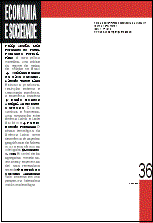Resumen
O objetivo do texto é identificar possíveis não linearidades na série de produção de bens de capital brasileira no período janeiro/1975-janeiro/2002. Utilizando a técnica de análise de séries temporais com diagramas de recorrência e o método de previsão por nearest neighbors, apresentam-se evidências de que os investimentos no Brasil – tomando como proxy a série temporal de produção de bens de capital – seguem uma dinâmica com um componente não linear determinístico não desprezível. Embora não tenha sido objetivo do texto identificar a possível fonte dessa dinâmica, os resultados empíricos alcançados autorizam a supor que a dinâmica macroeconômica brasileira pode ser mais sensível à variabilidade da política econômica do que normalmente se supõe. A implicação disso é que a capacidade de prever esses efeitos, com uma margem estatisticamente aceitável de significância, pode ser muito reduzida em períodos em que a dinâmica da série se torna mais sensível em relação às condições iniciais; as técnicas aqui empregadas, entretanto, sugerem que em certa medida é possível, senão prever a evolução dos investimentos, pelo menos identificar os períodos nos quais essa previsão é menos confiável.
Abstract
The objective of the paper is to identify possible non-linearities in Brazilian capital goods production in the period January/1975-January/2002. Using the techniques of recurrence plots diagrams and nearest neighbors forecasting, we found evidences that investments in Brazil present a non negligible non-linear component. Although it has not been the purpose of the paper to identify the possible source of that dynamics, the empiric results found authorize to speculate that the dynamics of some important macroeconomic variables in Brazil might be more sensitive to economic policy variability than it is usually supposed. The implication is that the ability to foresee those effects, within a significant statistical margin, can be very reduced in periods in which the dynamics of the series becomes more sensitive in relation to initial conditions; the techniques here deployed, however, suggest to be possible identify the periods where that forecast is less reliable.
Key words: Recurrence plots diagrams. Nearest neighbors. Capital goods – Brazil
Citas
BEVILACQUA, F. Nonlinear dynamics in US macroeconomic time series. MeritInfonomics RM 2001-035. 2001.
BEVILACQUA, F; VAN ZON, A. Random walks and non-linear paths in macroeconomic time series: some evidence and implications. 2001. Disponível em: http://www.wuwien.ac.at/inst/vw1/gee/papers/gee!wp22.pdf.
BROCK, W. D.; HSIEH, D.; LeBARON, B. Nonlinear dynamics, chaos, and instability. Cambridge, Mass.: MIT Press, 1993.
COOREY, S. The determinants of U.S. real interest rates in the long run. Washington, DC: IMF, 1991. (Working Paper, 118).
ECKMANN, J. P.; KAMPHORST, S. O.; RUELLE, D. Recurrence plots of dynamical systems. Europhysics Letters, 5, 1987.
ELMS, D. Forecasting in financial markets. In: CREEDY, J.; MARTIN, V. Chaos and non-linear models in economics. Aldershot, England: Edward Elgar, 1994.
FRASER, A. M.; SWINNEY, H. L. Independent coordinates for strange attractors from mutual information. Physical Review A, v. 33, n. 2, 1986.
GRANDMONT, J. (Ed.). Symposium on nonlinear economic dynamics. Journal of Economic Theory, v. 40, 1986.
HSIEH, D. Chaos and nonlinear dynamics: application to financial markets. The Journal of Finance, v HUNTER JR., F. N. Applications of nonlinear time-series models to driven systems. In: CASDAGLI, M.; EUBANK, S. (Ed.). Nonlinear modeling and forescasting. SFI Stud. Sci. Complexity, Proc., v. XII. Reading, Mass.: Addison-Wesley, 1992.
KONONOV, E. Visual recurrence analysis (VRA). 1999.
KYDLAND, F. E.; PRESCOTT, E. C. Hours and employment variation in business cycle theory. Economic Theory, v. 1, n. 1, 1991.
KYDLAND, F. E. Time to build and aggregate fluctuations. Econometrica, v. 50, n. 6, 1982.
PLOSSER, C. Understanding real business cycles. Journal of Economic Perspectives, v. 3, n. 3, Summer 1989.
MARWAN, N. Encounters with neighbours – current developments of concepts based on recurrence plots and their applications. Phd Thesis–Universitat Postdan, Fakultat Mathematik und Naturwissenschaften, Postdan, 2003.
MILLS, T. How robust is the finding that innovations to UK output are persistent. Scottish Journal of Political Economy, 39, 1992.
MIZRACH, B. Multivariate nearest-neighbour forecasts of EMS exchange-rates. Journal of Applied Econometrics, 7, 1992.
NELSON, C. R.; PLOSSER, C. I. Trends and random walks in macroeconomic time series: some evidence and implications. Journal of Monetary Economics, 10, 1982.
SCHEIKMAN, J. A. Nonlinearities in economic dynamics. Economic Journal, 100, Supplement. 1990.
SHANNON, C. E.; WEAVER W. The mathematical theory of communication. Chicago: University of Illinois Press, 1949.
SOSA, E. W. Testing for unity roots and trend breaks in Argentine real GDP. Economica, 43, 1997.
SUGIHARA, G.; MAY, R. M. Nonlinear forecasting as a way of distinguish chaos from measurement error in time series. Scripps Institute of Oceanography, University of San Diego, unpublished.
WEBER JR., C. L.; ZBILUT, J. P. Dynamical assessment of physiological systems and states using recurrence plot strategies. Journal of Applied Physiology, v. 76, n. 2, 1994.
WELIVITA, A. Cointegration tests and the long run purchasing power parity: examination of six currencies in Asia. Journal of Economic Development, 21, p. 103-115, 1998.
ZBILUT, J. P.; ZALDÍVAR-COMENGES, J. M.; STROZZI, F. Recurrence quantification based Lyapunov exponents for monitoring divergence in experimental data. Physics Letters A, v. 297, n. 3-4, 2002. . XLVI, n. 5, Dec. 1991.
A Economia e Sociedade utiliza a licença do Creative Commons (CC), preservando assim, a integridade dos artigos em ambiente de acesso aberto.

